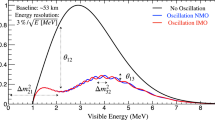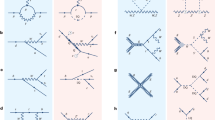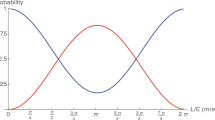Abstract
The charge-conjugation and parity-reversal (CP) symmetry of fundamental particles is a symmetry between matter and antimatter. Violation of this CP symmetry was first observed in 19641, and CP violation in the weak interactions of quarks was soon established2. Sakharov proposed3 that CP violation is necessary to explain the observed imbalance of matter and antimatter abundance in the Universe. However, CP violation in quarks is too small to support this explanation. So far, CP violation has not been observed in non-quark elementary particle systems. It has been shown that CP violation in leptons could generate the matter–antimatter disparity through a process called leptogenesis4. Leptonic mixing, which appears in the standard model’s charged current interactions5,6, provides a potential source of CP violation through a complex phase δCP, which is required by some theoretical models of leptogenesis7,8,9. This CP violation can be measured in muon neutrino to electron neutrino oscillations and the corresponding antineutrino oscillations, which are experimentally accessible using accelerator-produced beams as established by the Tokai-to-Kamioka (T2K) and NOvA experiments10,11. Until now, the value of δCP has not been substantially constrained by neutrino oscillation experiments. Here we report a measurement using long-baseline neutrino and antineutrino oscillations observed by the T2K experiment that shows a large increase in the neutrino oscillation probability, excluding values of δCP that result in a large increase in the observed antineutrino oscillation probability at three standard deviations (3σ). The 3σ confidence interval for δCP, which is cyclic and repeats every 2π, is [−3.41, −0.03] for the so-called normal mass ordering and [−2.54, −0.32] for the inverted mass ordering. Our results indicate CP violation in leptons and our method enables sensitive searches for matter–antimatter asymmetry in neutrino oscillations using accelerator-produced neutrino beams. Future measurements with larger datasets will test whether leptonic CP violation is larger than the CP violation in quarks.
This is a preview of subscription content, access via your institution
Access options
Access Nature and 54 other Nature Portfolio journals
Get Nature+, our best-value online-access subscription
$29.99 / 30 days
cancel any time
Subscribe to this journal
Receive 51 print issues and online access
$199.00 per year
only $3.90 per issue
Buy this article
- Purchase on Springer Link
- Instant access to full article PDF
Prices may be subject to local taxes which are calculated during checkout




Similar content being viewed by others
Data availability
The likelihood surface data that support these findings will be made available for public access on http://t2k-experiment.org/results/2020-constraint-cp-phase.
Code availability
The T2K collaboration develops and maintains the code used for the simulation of the experimental apparatus and statistical analysis of the raw data used in this result. This code is shared among the collaboration, but not publicly distributed. Inquiries regarding the algorithms and methods used in this result may be directed to the corresponding author.
Change history
18 June 2020
A Correction to this paper has been published: https://doi.org/10.1038/s41586-020-2415-5
References
Christenson, J. H., Cronin, J. W., Fitch, V. L. & Turlay, R. Evidence for the 2π decay of the \({K}_{2}^{0}\) meson. Phys. Rev. Lett. 13, 138–140 (1964).
Tanabashi, M. et al. Review of particle physics. Phys. Rev. D 98, 030001 (2018).
Sakharov, A. D. Violation of CP invariance, C asymmetry, and baryon asymmetry of the Universe. Pis’ma Z. Eksp. Teor. Fiz. 5, 32–35 (1967); Sov. Phys. Usp. 34, 392–393 (1991).
Fukugita, M. & Yanagida, T. Baryogenesis without grand unification. Phys. Lett. B 174, 45–47 (1986).
Fukuda, Y. et al. Evidence for oscillation of atmospheric neutrinos. Phys. Rev. Lett. 81, 1562–1567 (1998).
Ahmad, Q. R. et al. Direct evidence for neutrino flavor transformation from neutral current interactions in the Sudbury Neutrino Observatory. Phys. Rev. Lett. 89, 011301 (2002).
Pascoli, S., Petcov, S. T. & Riotto, A. Connecting low energy leptonic CP-violation to leptogenesis. Phys. Rev. D 75, 083511 (2007).
Hagedorn, C., Mohapatra, R. N., Molinaro, E., Nishi, C. C. & Petcov, S. T. CP violation in the lepton sector and implications for leptogenesis. Int. J. Mod. Phys. A 33, 1842006 (2018).
Branco, G. C., González Felipe, R. & Joaquim, F. R. Leptonic cp violation. Rev. Mod. Phys. 84, 515–565 (2012).
Abe, K. et al. Observation of electron neutrino appearance in a muon neutrino beam. Phys. Rev. Lett. 112, 061802 (2014).
Acero, M. A. et al. First measurement of neutrino oscillation parameters using neutrinos and antineutrinos by NOvA. Phys. Rev. Lett. 123, 151803 (2019).
Abe, K. et al. Search for CP violation in neutrino and antineutrino oscillations by the T2K experiment with 2.2 × 1021 protons on target. Phys. Rev. Lett. 121, 171802 (2018).
Abe, S. et al. Precision measurement of neutrino oscillation parameters with KamLAND. Phys. Rev. Lett. 100, 221803 (2008).
Adey, D. et al. Measurement of the electron antineutrino oscillation with 1958 days of operation at Daya Bay. Phys. Rev. Lett. 121, 241805 (2018).
Aharmim, B. et al. Combined analysis of all three phases of solar neutrino data from the Sudbury Neutrino Observatory. Phys. Rev. C 88, 025501 (2013).
Maki, Z., Nakagawa, M. & Sakata, S. Remarks on the unified model of elementary particles. Prog. Theor. Phys. 28, 870–880 (1962).
Pontecorvo, B. Neutrino experiments and the problem of conservation of leptonic charge. Sov. Phys. JETP 26, 984–988 (1968); Zh. Eksp. Teor. Fiz. 53, 1717 (1967).
Krastev, P. I. & Petcov, S. T. Resonance amplification and t violation effects in three neutrino oscillations in the Earth. Phys. Lett. B 205, 84–92 (1988).
Jarlskog, C. A basis independent formulation of the connection between quark mass matrices, CP violation and experiment. Z. Phys. C 29, 491–497 (1985).
Barger, V., Whisnant, K., Pakvasa, S. & Phillips, R. J. N. Matter effects on three-neutrino oscillations. Phys. Rev. D 22, 2718–2726 (1980).
Abe, K. et al. The T2K experiment. Nucl. Instrum. Methods A 659, 106–135 (2011).
Beavis, D., Carroll, A., Chiang, I. & the E889 Collaboration. Long Baseline Neutrino Oscillation Experiment At The AGS Physics design report BNL No. 52459 https://doi.org/10.2172/52878 (Brookhaven National Laboratory, 1995).
Otani, M. et al. Design and construction of INGRID neutrino beam monitor for T2K neutrino experiment. Nucl. Instrum. Methods A 623, 368–370 (2010).
Amaudruz, P. A. et al. The T2K fine-grained detectors. Nucl. Instrum. Methods A 696, 1–31 (2012).
Assylbekov, S. et al. The T2K ND280 off-axis pi-zero detector. Nucl. Instrum. Methods A 686, 48–63 (2012).
Abgrall, N. et al. Time projection chambers for the T2K near detectors. Nucl. Instrum. Methods A 637, 25–46 (2011).
Allan, D. et al. The electromagnetic calorimeter for the T2K near detector ND280. J. Instrum. 8, P10019 (2013).
Aoki, S. et al. The T2K Side Muon Range Detector (SMRD). Nucl. Instrum. Methods A 698, 135–146 (2013).
Fukuda, Y. et al. The Super-Kamiokande detector. Nucl. Instrum. Methods A 501, 418–462 (2003).
Nieves, J., Valverde, M. & Vicente Vacas, M. J. Inclusive nucleon emission induced by quasi-elastic neutrino-nucleus interactions. Phys. Rev. C 73, 025504 (2006).
Martini, M., Ericson, M., Chanfray, G. & Marteau, J. A unified approach for nucleon knock-out, coherent and incoherent pion production in neutrino interactions with nuclei. Phys. Rev. C 80, 065501 (2009).
Benhar, O., Farina, N., Nakamura, H., Sakuda, M. & Seki, R. Electron- and neutrino-nucleus scattering in the impulse approximation regime. Phys. Rev. D 72, 053005 (2005).
Salcedo, L. L., Oset, E., Vicente-Vacas, M. J. & Garcia-Recio, C. Computer simulation of inclusive pion nuclear reactions. Nucl. Phys. A 484, 557–592 (1988).
Böhlen, T. et al. The FLUKA code: developments and challenges for high energy and medical applications. Nucl. Data Sheets 120, 211–214 (2014).
Ferrari, A. Sala, P. R. Fasso, A. & Ranft, J. FLUKA: A Multi-Particle Transport Code Version 2005 CERN-2005–010, SLAC-R-773, INFN-TC-05–11 http://www.fluka.org/fluka.php?id=faq&sub=13 (FLUKA collaboration, 2005).
Brun, R. et al. GEANT Detector Description and Simulation Tool Report CERN-W5013 (CERN, 1994).
Abgrall, N. et al. Measurements of π±, K±, \({K}_{S}^{0}\), Λ and proton production in protoncarbon interactions at 31 GeV/c with the NA61/SHINE spectrometer at the CERN SPS. Eur. Phys. J. C 76, 84 (2016).
Abe, K. et al. Measurements of the T2K neutrino beam properties using the INGRID on-axis near detector. Nucl. Instrum. Methods A 694, 211–223 (2012).
Abgrall, N. et al. Measurements of π± differential yields from the surface of the T2K replica target for incoming 31 GeV/c protons with the NA61/SHINE spectrometer at the CERN SPS. Eur. Phys. J. C 76, 617 (2016).
Abgrall, N. et al. Measurements of π±, K± and proton double differential yields from the surface of the T2K replica target for incoming 31 GeV/c protons with the NA61/SHINE spectrometer at the CERN SPS. Eur. Phys. J. C 79, 100 (2019).
Hayato, Y. A neutrino interaction simulation program library NEUT. Acta Phys. Pol. B 40, 2477 (2009).
Llewellyn Smith, C. H. Neutrino reactions at accelerator energies. Phys. Rep. 3, 261–379 (1972).
Nieves, J., Amaro, J. E. & Valverde, M. Inclusive quasielastic charged-current neutrino-nucleus reactions. Phys. Rev. C 70, 055503 (2004).
Benhar, O. & Fabrocini, A. Two nucleon spectral function in infinite nuclear matter. Phys. Rev. C 62, 034304 (2000).
Nieves, J., Simo, I. R. & Vacas, M. J. V. Inclusive charged-current neutrino-nucleus reactions. Phys. Rev. C 83, 045501 (2011).
Gran, R., Nieves, J., Sanchez, F. & Vicente Vacas, M. J. Neutrino-nucleus quasi-elastic and 2p2h interactions up to 10 GeV. Phys. Rev. D 88, 113007 (2013).
Rein, D. & Sehgal, L. M. Neutrino-excitation of baryon resonances and single pion production. Ann. Phys. 133, 79–153 (1981).
Sjöstrand, T. High-energy physics event generation with PYTHIA 5.7 and JETSET 7.4. Comput. Phys. Commun. 82, 74–89 (1994).
Oset, E., Salcedo, L. L. & Strottman, D. A theoretical approach to pion nuclear reactions in the resonance region. Phys. Lett. B 165, 13–18 (1985).
Day, M. & McFarland, K. S. Differences in quasi-elastic cross sections of muon and electron neutrinos. Phys. Rev. D 86, 053003 (2012).
Rein, D. Angular distribution in neutrino induced single pion production processes. Z. Phys. C 35, 43–64 (1987).
Kabirnezhad, M. Single pion production in neutrino-nucleon interactions. Phys. Rev. D 97, 013002 (2018).
Yang, T., Andreopoulos, C., Gallagher, H., Hoffmann, K. & Kehayias, P. A hadronization model for few-GeV neutrino interactions. Eur. Phys. J. C 63, 1–10 (2009).
Jiang, M. et al. Atmospheric neutrino oscillation analysis with improved event reconstruction in Super-Kamiokande IV. Prog. Theor. Exp. Phys. 2019, 053F01 (2019).
Wilks, S. S. The large-sample distribution of the likelihood ratio for testing composite hypotheses. Ann. Math. Stat. 9, 60–62 (1938).
Feldman, G. J. & Cousins, R. D. A unified approach to the classical statistical analysis of small signals. Phys. Rev. D 57, 3873–3889 (1998).
Hastings, W. K. Monte Carlo sampling methods using Markov chains and their applications. Biometrika 57, 97–109 (1970).
Acknowledgements
We thank the J-PARC staff for superb accelerator performance. We thank the CERN NA61/SHINE Collaboration for providing valuable particle production data. We acknowledge the support of MEXT, Japan; NSERC (grant number SAPPJ-2014-00031), the NRC and CFI, Canada; the CEA and CNRS/IN2P3, France; the DFG, Germany; the INFN, Italy; the National Science Centre and Ministry of Science and Higher Education, Poland; the RSF (grant number 19-12-00325) and the Ministry of Science and Higher Education, Russia; MINECO and ERDF funds, Spain; the SNSF and SERI, Switzerland; the STFC, UK; and the DOE, USA. We also thank CERN for the UA1/NOMAD magnet, DESY for the HERA-B magnet mover system, NII for SINET4, the WestGrid and SciNet consortia in Compute Canada, and GridPP in the United Kingdom. In addition, participation of individual researchers and institutions has been further supported by funds from the ERC (FP7), “la Caixa” Foundation (ID 100010434, fellowship code LCF/BQ/IN17/11620050), the European Union’s Horizon 2020 Research and Innovation Programme under the Marie Sklodowska-Curie grant agreement numbers 713673 and 754496, and H2020 grant numbers RISE-RISE-GA822070-JENNIFER2 2020 and RISE-GA872549-SK2HK; the JSPS, Japan; the Royal Society, UK; French ANR grant number ANR-19-CE31-0001; and the DOE Early Career programme, USA.
Author information
Authors and Affiliations
Consortia
Contributions
The operation, Monte Carlo simulation, and data analysis of the T2K Experiment are carried out by the T2K Collaboration with contributions from all collaborators listed as authors on this manuscript. The scientific results presented here have been presented to and discussed by the full collaboration, and all authors have approved the final version of the manuscript.
Corresponding author
Ethics declarations
Competing interests
The authors declare no competing interests.
Additional information
Peer review information Nature thanks Anatael Cabrera, Alexandre Sousa and the other, anonymous, reviewer(s) for their contribution to the peer review of this work.
Publisher’s note Springer Nature remains neutral with regard to jurisdictional claims in published maps and institutional affiliations.
Extended data figures and tables
Rights and permissions
About this article
Cite this article
The T2K Collaboration. Constraint on the matter–antimatter symmetry-violating phase in neutrino oscillations. Nature 580, 339–344 (2020). https://doi.org/10.1038/s41586-020-2177-0
Received:
Accepted:
Published:
Issue Date:
DOI: https://doi.org/10.1038/s41586-020-2177-0
This article is cited by
-
News and views (1 & 2)
AAPPS Bulletin (2024)
-
Measurement of the axial vector form factor from antineutrino–proton scattering
Nature (2023)
-
QED radiative corrections for accelerator neutrinos
Nature Communications (2022)
-
The q-advanced Schrödinger equation: its characteristics and prospects
Quantum Studies: Mathematics and Foundations (2022)
-
Global oscillation data analysis on the 3ν mixing without unitarity
Journal of High Energy Physics (2021)
Comments
By submitting a comment you agree to abide by our Terms and Community Guidelines. If you find something abusive or that does not comply with our terms or guidelines please flag it as inappropriate.



